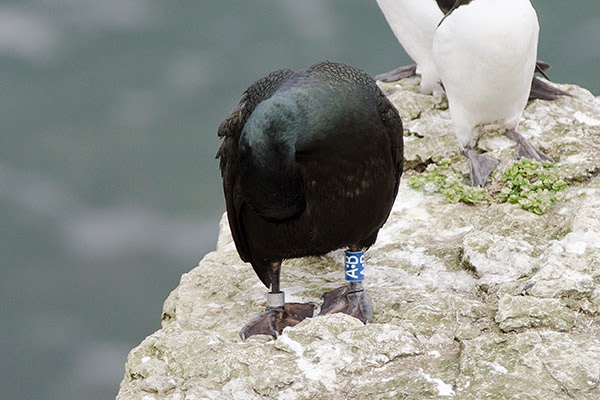For a change the boat picked us up from Penmon Point rather than Beaumaris and it was a grey and overcast start to the day.
A short hop across to the island and we were soon battling our way through the undergrowth to the ringing sites. SCAN are also undertaking a Razorbill RAS and my priority for the day was to try read and photograph has many Razorbill rings in the field as possible. Of course I took the opportunity to take other photos as well but ended up with at least 50 confirmed ring numbers and some we are still hoping to decipher. To do this meant slowly moving around the cliff top ledges and waiting patiently until the birds moved into a position where the ring could be seen and the number read.
Steve had been to Puffin the previous week to attach some data loggers to a few Razorbills. Once these birds have been recaptured a week or so later the data can be downloaded and this will tell us how long, how far and where the birds go to forage for food. This kind of information is vital at a time when many of our seabird colonies are in severe decline. I saw several of these birds.
Razorbills are fantastic birds close up and you can easily see where they got their name from. An adult gives you a nasty bite!
The Shag RAS colour ringing project got off to a good start and I picked up several colour ringed birds during my sojourn along the cliff tops including this male A:B inspecting his ring!
Male Shags bark at you on the nest and moving along the ledges I'd quite often get barked at by a male sitting tight on his nest whilst the female was off fishing or preening somewhere.
Many of the Razorbills had eggs beneath boulders and overhangs. Guillemots tend to lay their eggs on open ledges so we were very careful not to disturb them and risk the eggs getting predated or pushed off the ledges. This bird had decided to lay right out in the open and I don't rate the eggs chance of surviving to long!
No trip to Puffin Island would be complete without seeing at least one of its namesakes!
Fulmars and Kittiwakes are also back on their breeding ledges although probably not on eggs yet.
The gull colony was particularly active and I was bombarded wit ha steady stream of guano from above whenever I happened to be in the vicinity. The greater Black-backs were particularly aggressive and I got 'hit' on numerous occasions as they did their best to decapitate me. Luckily I had a 'hoodie' on and spent most of the time with my head covered.
Adult herring Gull giving me the evil eye.
The gulls eggs were fascinating due to the variation in colour between nests of the same species and also within the same nest. Some of the nests had hatched and others were beginning to 'chip' with the chicks egg tooth just being visible.
Gulls egg chipping:
With the boat picking us up at 16.30 we just had time to relax on the beach and watch the Eiders and seals for half an hour in the sunshine. Another fantastic day and I feel very privileged to be able to get so close to some fantastic birds. The company wasn't bad either..................



















































































No comments :
Post a Comment